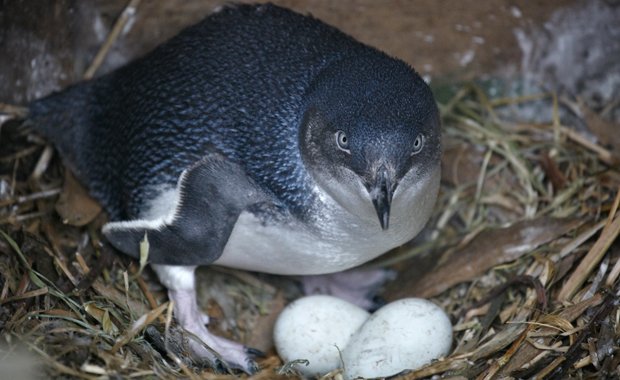Weed control looks good for fairy penguins

MONTAGUE ISLAND, on the south coast of NSW, is home to the third largest colony of little (or fairy) penguins in the world, numbering approximately 6000 pairs. An ongoing grass-control project on the island aims to return the island to native vegetation cover, in the hope that this will help boost penguin populations.
Back in 2001, research showed that invasive kikuyu grass was spreading across the island at an alarming rate and dominating native vegetation. Originally introduced as feed for livestock and to prevent soil erosion in the windy conditions, the grass increased its coverage on the southern part of the island from 26 per cent in 1992 to 40 per cent in 2000. The grass forms extensive mats 1-2 m beneath the soil that disrupt breeding and nesting burrows of shearwaters and little penguins. The density of the kikuyu resulted in up to 300 penguins per year being entangled in the grass, sometimes fatally.
As a result of the study, The NSW National Parks and Wildlife Service (NPWS) decided that control measures should be implemented in order to protect the penguin population.
Fairy penguin monitoring
Further research from Charles Sturt University determine the best control methods, and since 2004 the spread of kikuyu has been diminished through a combination of spraying, burning, and revegetation of native species like lamandra, banksia, acacia and casuarina. The program has resulted in a 50% decrease in kikuyu cover since 2000.
Part of the ongoing control program is the monitoring of penguin numbers to determine their breeding success as a result of the program. About 120 penguin nesting boxes have been placed around the island to facilitate the monitoring.
During my visit, I went out with NPWS ranger Dave Blakeney on a penguin survey to collect information about how many of the boxes were occupied, and by how many penguins. Tramping through thick scrub on the protected, western side of the island, we sought out the penguin boxes hidden amongst the undergrowth.
Lifting the lids on the boxes revealed adult penguins and chicks of various age – from unhatched eggs to six-week-old chicks that were nearly ready to take their first steps out of the nest. One particularly houseproud mother wasn’t too happy about the unannounced inspection and took a couple of pecks at my foot, reinforcing my sensible decision to leave my thongs at home that day.
Volunteering on Montague
During peak breeding season (August-January), penguin surveys are usually conducted weekly by the resident park rangers, and often with the help of volunteers provided by Conservation Volunteers Australia.
Officially, 2010 was the first full season of monitoring, although some of the older boxes have been monitored for several years. The data collected by the survey will eventually be compared against previous data to determine the effect of the control program on the penguin populations of the island.
With just one full year of surveys completed, it is still too early to gauge the overall effect with any certainty. However, Mark Westwood, the ranger overseeing the survey, says that the anecdotal evidence seems to point to an increase in the penguins coming ashore at Montague.
Volunteers can spend a couple of nights in the recently restored lighthouse keepers’ quarters, and during their time on the island are also enlisted to help with the revegetation program, planting natives in areas that were previously over-run with kikuyu grass.
Find more information on volunteering here and general information on Montague Island at http://www.montagueisland.com.au/.
Former Australian Geographic Art Director Mike Rossi spent a few days on NSW’s Montague Island, here he reports back on what he found. Find another blog in this series here.

